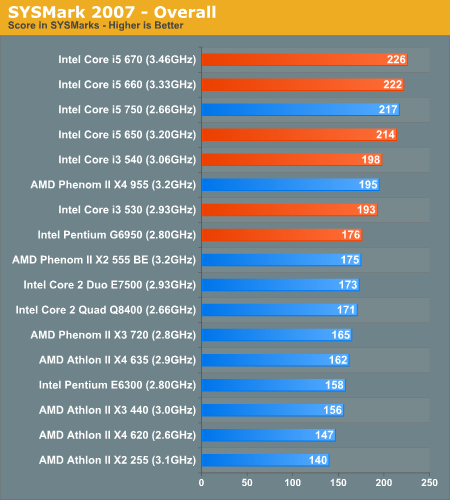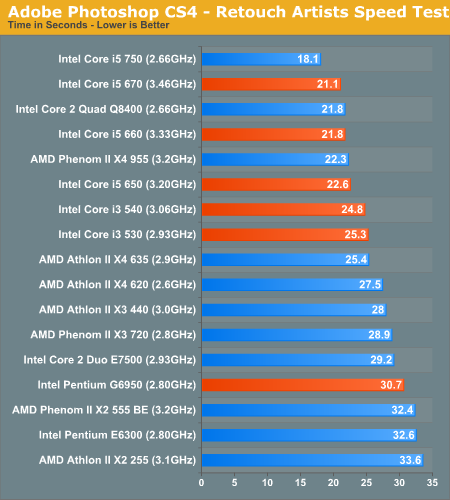The Rest of Clarkdale: Intel's Pentium G6950 & Core i5 650/660/670 Reviewed
by Anand Lal Shimpi on March 24, 2010 4:00 PM EST- Posted in
- CPUs
SYSMark 2007 Performance
Our journey starts with SYSMark 2007, the only all-encompassing performance suite in our review today. The idea here is simple: one benchmark to indicate the overall performance of your machine.

SYSMark ends up being a fairly lightly threaded test, optimized mostly for dual core processors. As such, the Athlon II X3 doesn't really get much benefit from that third core and ends up being more of a Penryn competitor than in the same class as the Core i5/i3 and Pentium G6950.
As a business desktop machine, the Pentium G6950 is a competant option. Clearly slower than the Core i3 530 but not much else. The faster dual core i5s do well here.
Adobe Photoshop CS4 Performance
To measure performance under Photoshop CS4 we turn to the Retouch Artists’ Speed Test. The test does basic photo editing; there are a couple of color space conversions, many layer creations, color curve adjustment, image and canvas size adjustment, unsharp mask, and finally a gaussian blur performed on the entire image.
The whole process is timed and thanks to the use of Intel's X25-M SSD as our test bed hard drive, performance is far more predictable than back when we used to test on mechanical disks.
Time is reported in seconds and the lower numbers mean better performance. The test is multithreaded and can hit all four cores in a quad-core machine.

For a photoshop workstation, Intel's quad-core i5 can't be beat by anything in the i5 lineup - even if you spend more than $200. The Pentium G6950 doesn't do so well here. While it's faster than the Pentium E6300, it's slower than the Core 2 Duo E7500 and AMD's Athlon II X3 440. Photoshop likes to spawn CPU intensive threads and thus Hyper Threading actually matters here. You'll want at least an i5 if you're building a good Photoshop box.










70 Comments
View All Comments
Taft12 - Thursday, March 25, 2010 - link
Citation needed? I've worked with many Intel and AMD systems (mostly Linux however) and never ran into a problem with AHCI. Also, is SATA performance truly impacted assuming you are using mechanical hard drives?KaarlisK - Thursday, March 25, 2010 - link
A citation regarding the performance:http://techreport.com/articles.x/18539/8">http://techreport.com/articles.x/18539/8
http://techreport.com/articles.x/18539/7">http://techreport.com/articles.x/18539/7
And USB/PCI/PCIe performance (or CPU usage) is also worse:
http://techreport.com/articles.x/18539/9">http://techreport.com/articles.x/18539/9
And a direct quote from TechReport:
"Unfortunately, AMD's longstanding issues with AHCI Serial ATA controller configurations persist in the SB750, all but forcing users to run the south bridge in plain old IDE mode. That's not the end of the world, but IDE mode doesn't support Serial ATA perks like hot swapping and Native Command Queuing."
As for problems getting it to work at all, the views are conflicting: http://techreport.com/forums/viewtopic.php?f=36&am...">http://techreport.com/forums/viewtopic.php?f=36&am...
But the fact is, I've had problems installing Win7 in AHCI mode on SB700, then tried the same drive with the ICH7MDH in AHCI mode, and it worked flawlessly.
CSMR - Wednesday, March 24, 2010 - link
Advice: If you're going to measure power consumption you should use more appropriate components. People have been getting <25W system idle with some of the Clarkdales.Question: are video acceleration features available for all the Clarkdale processors here?
AtenRa - Wednesday, March 24, 2010 - link
The numbers at Idle are with the GTX280 (i guess) and not with the intergraded Graphics. ;)clarkn0va - Wednesday, March 24, 2010 - link
You seem to have missed a couple distinguishing features of the new LGA1156 Pentium. First, it supports ECC when paired with Intel's 3450 chipset. I'm still trying to figure out why (or why Intel doesn't include ECC support on all their CPUs, like AMD does).Second would be the "Embedded" designation. I'm not exactly sure what Intel is trying to denote with that, as this is no Atom or Geode with a TDP of 73 Watts.
http://download.intel.com/pressroom/kits/embedded/...">http://download.intel.com/pressroom/kits/embedded/...
Perisphetic - Wednesday, March 24, 2010 - link
I think the major reason is the FUD of how well would the server CPUs fare if Intel did release ECC for the desktop family of CPUs. The problem is that LGA 1156 slots everything from i3, i5, i7 to Xeons. With the proper BIOS you can run a server board with an i7 or vice versa a Xeon in a desktop motherboard. If i7 did have ECC who would buy the Xeons at twice the price. Sure the Xeons have some fancy server features but if you could buy an ECC enabled i7 at half the cost no one would even consider the Xeons.clarkn0va - Thursday, March 25, 2010 - link
"if you could buy an ECC enabled i7 at half the cost no one would even consider the Xeons."Right. Which makes me wonder why this pentium has ECC enabled. It's not an i7, but it's enough of a CPU to fit the bill on many servers, and will take some business away from the higher-priced low-end Xeons.
has407 - Wednesday, March 24, 2010 - link
Embedded means Intel will continue to ship the product for 7+ years. That designation is applied to many different products from CPU's to chipsets, and includes (some) high-power parts.SgtSpoon - Wednesday, March 24, 2010 - link
How can the G6950 outperform the i3 530 in fallout 3?SgtSpoon - Wednesday, March 24, 2010 - link
Also : "As a gaming CPU the Petnium G6950 is on par with the Athlon II X3 440 in our Fallout 3 test"Petnium? :)